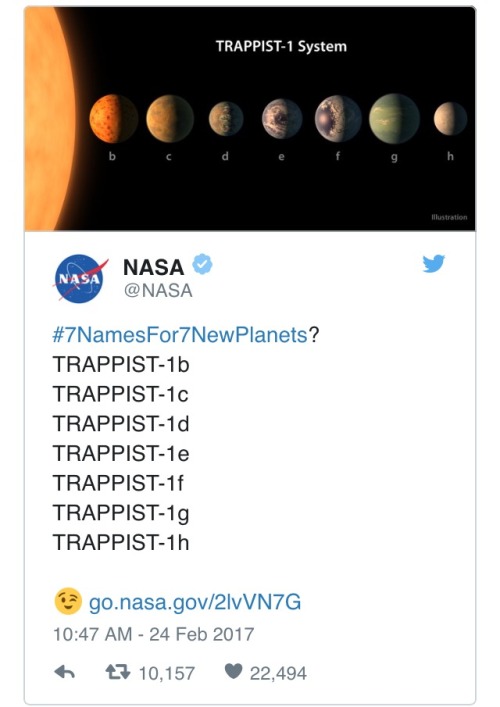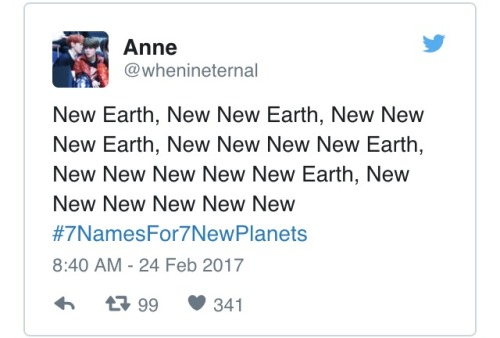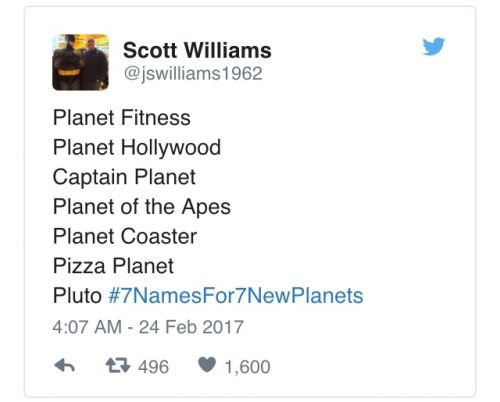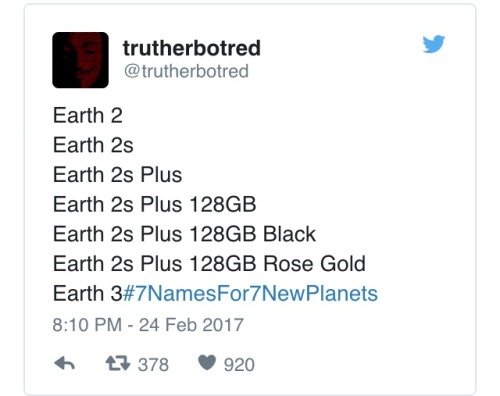Allow Us To Reintroduce Someone … The Name’s Perseverance.
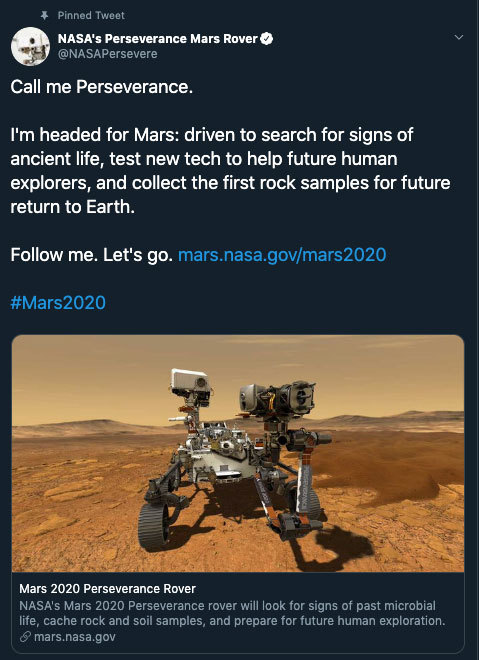
Allow us to reintroduce someone … the name’s Perseverance.
With this new name, our Mars 2020 rover has now come to life! Chosen by middle school student Alex Mather, Perseverance helps to remind ourselves that no matter what obstacles we face, whether it’s on the way to reaching our goals or on the way to Mars, we will push through. In Alex’s own words,
“We are a species of explorers, and we will meet many setbacks on the way to Mars. However, we can persevere. We, not as a nation but as humans, will not give up. The human race will always persevere into the future.”
Welcome to the family. ❤️
Make sure to follow us on Tumblr for your regular dose of space: http://nasa.tumblr.com.
More Posts from Fillthevoid-with-space and Others

One-year countdown to solar eclipse, August 21, 2017: path of totality overlaid on U.S. population density and interstate map.
Does all capsules drops in Kazakhstan on return after every mission?
Since the US Space Shuttle retired in 2011, we launch to and return from the Space Station with the Russian Space Agency. So yes, these capsules (the Soyuz) land in Kazakhstan (or surrounding regions). However, different spacecrafts have different reentry trajectories, depending on where they aim to land. As you might recall, the Apollo mission capsules landed in the ocean. Since Space-X and Boeing are currently building new vehicles so that we will also launch from the US again to get to the International Space Station, these spacecraft will return to the US. For example, you may have seen footage of Space-X cargo vehicles splashing down into the Pacific over the last few years. The Boeing Starliner plans to land on land instead of water. NASA is also currently building the Orion spacecraft, which will take us to destinations beyond low earth orbit (where the Space Station is), whether that be the Moon or Mars or another target. Orion will also splash down in the ocean.

In the ancient world (and, honestly, today too) there’s nothing spookier than the sky doing something weird. Auroras, meteors, comets, and eclipses all fell under the category of scary, prophetic bad omens, but don’t worry! In this podcast I explain what they are! There are also some opportunities to see these astronomical events in action coming up. The annual Perseid meteor shower reaches its peak August 11-13 and there will be a total eclipse of the Sun (or a partial eclipse, depending where you’re viewing it from) across North America on August 21, 2017.
Below the cut are sources, music credits, vocabulary list, and the transcript of this episode. Check out the glossary, it’s a big one! There are also some cool eclipse-viewing resources I’ll highlight so you can view this phenomenon safely.
Let me know what you think I should research by messaging me here, tweeting at me at @HDandtheVoid, or asking me to my face if you know me in real life. And please check out the podcast on iTunes, rate it or review it if you’d like, subscribe, and maybe tell your friends about it if you think they’d like to listen!
(My thoughts on the next episode were spectroscopy, probes through the ages, and the transit of Venus. Let me know by the 2nd and I’ll have the next podcast up on August 14th, barring any delays due to trip fatigue!)
Glossary
auroras - a light display that occurs when a magnetosphere is sufficiently disturbed by solar wind that charged particles scatter into the upper atmosphere and lose their energy.
comet - a small, icy body that orbits the Sun. When its orbit takes it close to the Sun, the comet warms up and releases gases and debris that produce a visible atmosphere, sometimes called the comet’s tail.
corona - the hot outer atmosphere of the Sun.
eclipse - when three celestial bodies line up so that one obstructs the visibility of the other two. A solar eclipse can be partial (only part of the Sun is obscured by the Moon), total (all of the Sun is hidden by the Moon), or annular ( the Moon is close to Earth and appears too small to completely cover the Sun completely).
Exeligmos cycle - a cycle that is 3 times the saros cycle, or 669 months. It is more accurate means of predicting eclipses and additionally predicts eclipses that will be visible from a location close to the initial eclipse.
Inex cycle - a cycle of 28 years and 345 days long used to predict an eclipse that’s visible in the opposite hemisphere. For example, if an eclipse happens in the Northern hemisphere, one Inex cycle later there will be an eclipse visible in the Southern hemisphere. The Inex cycle does not ensure that both kinds of eclipses will be of the same type.
meteor - a small rocky or metallic body in space, smaller than asteroids. Contact with the Earth’s atmosphere causes a meteor to burn up in a streak of light. Many meteors entering the atmosphere within a few minutes of each other is called a meteor shower. If a meteor impacts on Earth’s surface without burning up, it is then classified as a meteorite.
penumbra - a region where only a portion of the light source is obscured. When the light source is completely blocked, this darkest part of a shadow is called the umbra.
perihelion - an object’s closest approach to the Sun in its orbit. Its greatest distance from the Sun is called its aphelion.
perigee - a satellite’s closest approach to the Earth in its orbit. Its greatest distance from Earth is called its apogee.
radiant - the point in the sky where objects appear to come from. For example, the Perseid meteor shower appears to come from the constellation Perseus.
Saros cycle - a cycle of 223 months that is used to predict eclipses.
solar prominence - a large, bright feature anchored to the Sun's surface and extend outwards into the Sun's corona. A prominence forms in about a day out of plasma, a hot gas made of electrically charged hydrogen and helium. Stable prominences may last for several months, looping hundreds of thousands of miles into space as plasma flows along a structure of the Sun’s magnetic field that has burst outward, releasing the plasma.
syzygy - the straight-line alignment of three celestial bodies.
Script/Transcript
Sources
Perseids via EarthSky
Perseids via NASA
Meteor showers and viewing tips via StarDate
Comet Swift-Tuttle via NASA
My local library’s information and recommended reading list for learning about eclipses. Love you, Multnomah County!
Map of the Path of Totality across the United States
Solar eclipse map and calendar via the Exploratorium website
Free eclipse glasses at libraries via Lunar and Planetary Institute
Guide to making a pinhole camera to view the eclipse via NASA
Historical eclipses via NASA
Historical eclipses via Astronomy Magazine
“Even if the Moon, however, does sometimes cover the Sun entirely, the eclipse does not have duration or extension; but a kind of light is visible about the rim which keeps the shadow from being profound and absolute.”
Solar prominence via NASA
Solar flares via NASA
Fred Espenak’s guide to eclipses. He’s a former NASA astrophysicist who’s credited with all the eclipse predictions so I trust him.
Some good but confusing charts on solar eclipse Saros cycles via NASA
“Van den Bergh placed all 8,000 solar eclipses in von Oppolzer's Canon der Finsternisse (1887) into a large two-dimensional matrix. Each Saros series was arranged as a separate column containing every eclipse in chronological order. The individual Saros columns were then staggered so that the horizontal rows each corresponded to different Inex series.”
A Danish webpage on calculating eclipses
Hawks, Ellison. The Boy’s Book of Astronomy. Frederick A. Stokes Co: New York, 1914. Located in Google Books preview. (Heads up, this is a fairly racist source.)
Richard Cohen. Chasing the Sun. Random House: NY, 2010.
Robert A. Henning: “different forms, wavering, many colours diffusing and changing, sometimes far away, sometimes filling the heavens around and above, plunging great dropping spears and sheets of colour earthward towards your very head as though a great hand were dropping colour like burning oil” (43).
Ernest W. Hawkes: “whistling, crackling noise” (44).
Jeremy Belknap: “like running one’s thumb and forefinger down a silk scarf” (44).
Intro Music: ‘Better Times Will Come’ by No Luck Club off their album Prosperity
Filler Music: ‘Eclippse’ by Radical Face off his album Sunn Moonn Eclippse. Check out the video in the album link, it’s amazing.
Outro Music: ‘Fields of Russia’ by Mutefish off their album On Draught

Margaret Hamilton is a computer scientist and mathematician. She was the lead software engineer for Project Apollo. Her work prevented an abort of the Apollo 11 moon landing. She’s also credited for coining the term “software engineer."

Observing stars is all well and good, but how can I use stars to make my life easier? With a few handy tools and a lot of complicated math and careful table scouting, of course! Okay, it’s not actually any easier to tell where you are, predict when the Sun will rise or where the star Rigel will be at 11:36pm EST, or guess when the next eclipse will be using these tools, but if you don’t have a computer handy maybe it will help.
I did my best to describe all these odd devices in the clearest terms I could but you can hit me up with questions if you have them! Definitely check out some of the video links if you can’t quite picture what I said. I’m also on Twitter at @HDandtheVoid if you’d rather ask me there. And please check out the podcast on iTunes, rate it or review it if you’d like, and subscribe! I’ll always post all the extras here on Tumblr but iTunes is probably more convenient for downloading.
Below the cut are my sources, music credits, vocab list, and the transcript. I mention a play and a story/book and quote an astronomy book in this episode so if you want to see that written down, those sources are there as well. Let me know what you think of this episode, let me know what you think I should research next*, tell me a fun space fact… anything’s helpful!
*(My thoughts were planets, spectroscopy, or Edmond Halley. Let me know by the 6th and I’ll have the next podcast up by July 17th!)
Glossary:
armillary sphere - a device showing the apparent daily motion of the Sun depending on the season, the date, and the latitude of observation. See example video in the link.
Antikythera Mechanism - a device used to establish a calendar based on the Metonic Cycle; eclipse prediction; the location of planets, the Sun, and the Moon on a particular day; and determine the phase of the Moon on a particular day. See example video in the link.
astrolabe - a device for measuring the altitudes of certain celestial objects and for calculating latitude before the development of the sextant. One side is indented, the space called the mater, and can hold a plate depicting the local latitude. Over this plate is a rete, which points out different fixed stars as well as the Sun’s ecliptic, divided into 30 degree sections representing the zodiac signs. On top of the rete was a clock-like hand that stretched the diameter of the astrolabe, called the rule. The rule and rete could be rotated over the face of the plate. See example in the link.
azimuth - a section of the horizon measured between a fixed point and the vertical circle passing through the center of an object. See example in the link.
declination - the angle of the Sun relative to the equator. The Sun’s angle changes with the seasons.
ecliptic - the path of the Sun over the course of a year.
exeligmos cycle - a cycle that is 3 times the saros cycle, or 669 months. It is more accurate means of predicting eclipses and additionally predicts eclipses that will be visible from a location close to the initial eclipse.
kamal - an Arabic navigation tool consisting of a knotted string and a piece of wood. A navigator would tie a knot in the string and, by holding it in their teeth, sight the North Star along the top of the wooden piece and the horizon along the bottom. To return home, the navigator would sail north or south to bring Polaris to the altitude they had observed in their home port, then turn left or right and sail down the latitude, keeping Polaris at a constant angle. Over time, Arab navigators started tying knots at regular intervals of a fingerwidth, called an issbah, that’s about 1 degree and 36 minutes.
metonic cycle - a 19-year cycle developed by the Babylonians to sync their lunar months with the solar year. In the Metonic cycle, there would be 12 years that lasted 12 lunar months and 7 years that lasted 13 months.
saros cycle - a cycle of 223 months that is used to predict eclipses.
sextant - a device used to determine an observer’s location based on the observation of a known celestial object and a lot of calculation. It is still in use by sailors.
stereographic projection - a process for depicting a spherical, 3-dimensional object on a flat surface. An imaginary line is drawn from one point on the object to a point on the flat surface, following an angle to achieve the same relationship between each point on the object. See example in the link
Script/Transcript
Sources:
Video of how to use an armillary sphere
History of the armillary sphere via University of Cambridge
Video lecture on using an armillary sphere. It sounds like he’s trying to sell it.
Video of how to use an astrolabe
Make your own astrolabe suggestions via In the Sky.org
An old guy kept up a website on astrolabes but he died in April 2016, it’s very sad. Excellent info though.
Explanation of unequal hours
Pullman Car Hiawatha summary, just to prove it’s a real play
Chaucer’s Canterbury Tales with its brief astrolabe mention
Video on how to use a sextant
The many uses of a sextant via Classic Sailing
Why a sextant works via Trailnotes
The history of the sextant
The definition of azimuth
The definition of declination
Video of Antikythera Mechanism’s virtual model based on a theoretical and mechanical model. Just a theoretical model!
Antikythera Mechanism via Smithsonian Magazine
The Antikythera Mechanism Research Project website
Antikythera Mechanism via The New Yorker
Saros cycle via NASA
Saros and Exeligmos cycles
Crouper, Heather and Nigel Henbest. The History of Astronomy. Firefly Books: Buffalo, NY, 2007.
“The circular gear wheels of the Antikythera Mechanism reflect the ancient Greeks’ preoccupation with circles—and with the idea that everything in the sky moves around in circular paths, because the heavens are the home of perfection, and a circle is the ideal shape.” (59)
Intro Music: ‘Better Times Will Come’ by No Luck Club off their album Prosperity
Filler Music: ‘Brooklyn Nights Guitar’ loop from Garageband
Outro Music: ‘Fields of Russia’ by Mutefish off their album On Draught
I found a bizarre open-access, peer-review journal of STEM research. It was hard for me to find anything that pertained to astronomy or any of the stellar studies, but I did find a couple categories I could investigate:
Astrobiology
Astronomical Sciences
Spectroscopy (I didn’t see any astronomical spectroscopy stuff but who knows)
Just looking at the articles popping up suggests that it would take some serious digging to find anything (and I would certainly have to work on my keyword optimization techniques because typing ‘space’ into the search bar got me nothing relevant to my interests), but it’s a new potential resource! And for anyone who wants to find a way to publish in STEM fields, maybe it’s something worth checking out?
I just watched the 4 clearly visible planets march across the sky with the moon in the center, so here’s a short guide to the night sky as the last 3 move across.
mammenxTime lapse of the milky way rolling across the night sky, flanked by the planets Jupiter, Saturn & Mars. Taken from Diskit Ladakh, this place truly has some fantastic unobstructed views of the night sky

sun depicted as a divinity petroglyph on the plateau Yagour (High Atlas mountains), Morocco.. 6000 to 8000 BC
-
 thewriteitinerary reblogged this · 2 months ago
thewriteitinerary reblogged this · 2 months ago -
 kymera-warren liked this · 3 months ago
kymera-warren liked this · 3 months ago -
 cloverosita246 liked this · 5 months ago
cloverosita246 liked this · 5 months ago -
 strawberrycatworld reblogged this · 5 months ago
strawberrycatworld reblogged this · 5 months ago -
 strawberrycatworld liked this · 5 months ago
strawberrycatworld liked this · 5 months ago -
 sk8echo liked this · 1 year ago
sk8echo liked this · 1 year ago -
 yellowsandgreens liked this · 1 year ago
yellowsandgreens liked this · 1 year ago -
 booooop-a-loop liked this · 1 year ago
booooop-a-loop liked this · 1 year ago -
 tiodingbhanopap liked this · 1 year ago
tiodingbhanopap liked this · 1 year ago -
 somethinggsomething reblogged this · 1 year ago
somethinggsomething reblogged this · 1 year ago -
 flowersandcandy06 liked this · 2 years ago
flowersandcandy06 liked this · 2 years ago -
 silentknight-wdfg liked this · 2 years ago
silentknight-wdfg liked this · 2 years ago -
 ex-libris-thechesterfield reblogged this · 2 years ago
ex-libris-thechesterfield reblogged this · 2 years ago -
 iwillhaveamoonbase liked this · 2 years ago
iwillhaveamoonbase liked this · 2 years ago -
 misshasclass reblogged this · 2 years ago
misshasclass reblogged this · 2 years ago -
 ladysmithereen reblogged this · 3 years ago
ladysmithereen reblogged this · 3 years ago -
 ladysmithereen liked this · 3 years ago
ladysmithereen liked this · 3 years ago -
 nishiki-san-blog1 liked this · 3 years ago
nishiki-san-blog1 liked this · 3 years ago -
 thankfkforsummer reblogged this · 3 years ago
thankfkforsummer reblogged this · 3 years ago -
 artistlearningsstuff liked this · 3 years ago
artistlearningsstuff liked this · 3 years ago -
 carpatcan liked this · 3 years ago
carpatcan liked this · 3 years ago -
 fadingartisanfreakwinner liked this · 3 years ago
fadingartisanfreakwinner liked this · 3 years ago
A podcast project to fill the space in my heart and my time that used to be filled with academic research. In 2018, that space gets filled with... MORE SPACE! Cheerfully researched, painstakingly edited, informal as hell, definitely worth everyone's time.
243 posts

